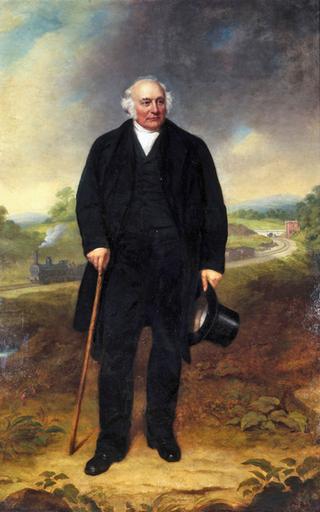
Watercolour of a lane scene at Mor near Barh, India
- Made:
- 1856-02-06 in India
- maker:
- S A Stewart

Painting, watercolour, Lane scene at Mohr (now Mor) near Barh, Bengal (modern-day Bihar), by S A Stewart, 6 February 1856. Depicts a lane running through a Bengali village. There are houses and fences on either side, with a tall palm tree at right amidst smaller trees. Further trees form the backdrop to the village. Inscription and date in pencil on the reverse together with the words "S. A. Stewart fecit". Painted on an arched sheet of paper, gummed to another sheet, possibly from an album. From the collection of George Turnbull, Chief Engineer, East Indian Railway.
The painting's artist, S. A. Stewart, was an Assistant Engineer on the East Indian Railway. Stewart was based in Barh, on the banks of the River Ganges, 300km to the east of the terminus at Benares (now Varanasi). This painting was made in February 1856, at a time when Turnbull was travelling along the line to inspect the ongoing works as well as settle contractual matters. Perhaps Stewart gave the painting to Turnbull during his visit. Little else is currently known about Stewart.
Scottish engineer George Turnbull (1809-1889) oversaw the creation of one of the first railways in India, the East Indian Railway (EIR). The EIR ran from near Calcutta (now Kolkata), an East India Company trading post in the north-east that the Company established as the capital from 1773. The terminus was originally Benares (now Varanasi), but the line quickly extended to New Delhi in the north, which became the capital of India in 1911. Calcutta and New Delhi are over 1,300km miles from each other – further than the distance between Paris, France and Budapest, Hungary.
Turnbull collected artworks during his time in India, many of which were produced by EIR engineers. These watercolours and drawings provide a rare view of nineteenth-century India from the perspective of the British engineers designing and building the country’s first railways. The collection includes landscape scenes and portraits. While many of the landscapes show the construction of the railway, others focus entirely on India’s local architecture or its rural spaces. The portraits are of people Turnbull encountered while in India. While the portraits of British people are inscribed with their names, most of the Indian people depicted remain anonymous or identified only by their job.
The British introduced railways in India to satisfy the mounting economic and military needs of their colonial administration. They hoped that the new technology would foster an increased sense of collective identity by making it easier to travel quickly between distant regions. They also hoped the railways would socially ‘improve India’ by instilling a sense of punctuality among Indians, a quality British colonialists believed Indians lacked. The racist stereotypes underpinning these intentions, and the interconnected idea that technology could trigger social change, were common beliefs in nineteenth-century British society.
Details
- Category:
- Pictorial Collection (Railway)
- Object Number:
- 2017-7093
- Materials:
- paper (fibre product) and watercolour (paint)
- type:
- painting, watercolour




